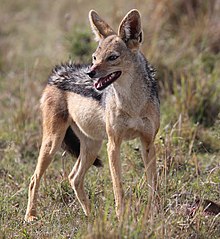
Back Šakal čabrakový Czech Schabrackenschakal German Lupulella mesomelas Spanish شغال پشتسیاه Persian Vaippasakaali Finnish Chacal à chabraque French תן שחור-גב HE Panyókás sakál Hungarian Lupulella mesomelas Italian セグロジャッカル Japanese
| Black-backed jackal Temporal range: Pliocene – recent
| |
|---|---|

| |
| L. m. schmidti in Masai Mara, Kenya | |
| Scientific classification | |
| Domain: | Eukaryota |
| Kingdom: | Animalia |
| Phylum: | Chordata |
| Class: | Mammalia |
| Order: | Carnivora |
| Family: | Canidae |
| Subfamily: | Caninae |
| Tribe: | Canini |
| Subtribe: | Canina |
| Genus: | Lupulella |
| Species: | L. mesomelas
|
| Binomial name | |
| Lupulella mesomelas (Schreber, 1775)
| |
| Subspecies | |
|
2 subspecies, see text | |

| |
| Black-backed jackal range, with L. m. mesomelas in blue and L. m. schmidti in red | |
| Synonyms | |
|
Canis mesomelas[2] | |
The black-backed jackal (Lupulella mesomelas),[3][4][5][6] also called the silver-backed jackal, is a medium-sized canine native to eastern and southern Africa. These regions are separated by roughly 900 kilometers.
One region includes the southernmost tip of the continent, including South Africa, Namibia, Botswana, and Zimbabwe. The other area is along the eastern coastline, including Kenya, Somalia, Djibouti, Eritrea, and Ethiopia.[7] It is listed by the IUCN as least concern, due to its widespread range and adaptability, although it is still persecuted as a livestock predator and rabies vector.[1]
Compared to members of the genus Canis, the black-backed jackal is a very ancient species, and has changed little since the Pleistocene,[8] being the most basal wolf-like canine, alongside the closely related side-striped jackal.[9] It is a fox-like animal[10] with a reddish brown to tan coat and a black saddle that extends from the shoulders to the base of the tail.[11] It is a monogamous animal, whose young may remain with the family to help raise new generations of pups.[12] The black-backed jackal has a wide array of food sources, feeding on small to medium-sized animals, as well as plant matter and human refuse.[13]
- ^ a b Hoffmann, M. (2014). "Canis mesomelas". IUCN Red List of Threatened Species. 2014: e.T3755A46122476. doi:10.2305/IUCN.UK.2014-1.RLTS.T3755A46122476.en. Retrieved 14 March 2022.
- ^ Cite error: The named reference
Wozencraft2005was invoked but never defined (see the help page). - ^ Cite error: The named reference
MDDwas invoked but never defined (see the help page). - ^ Cite error: The named reference
Alvares2019was invoked but never defined (see the help page). - ^ Cite error: The named reference
Perri2021was invoked but never defined (see the help page). - ^ Cite error: The named reference
Castello2018was invoked but never defined (see the help page). - ^ Aerts, Raf (2019). Forest and woodland vegetation in the highlands of Dogu'a Tembien. In: Nyssen J., Jacob, M., Frankl, A. (Eds.). Geo-trekking in Ethiopia's Tropical Mountains – The Dogu'a Tembien District. SpringerNature. ISBN 978-3-030-04954-6. Retrieved 18 June 2019.
- ^ Kingdon, J. (1977), East African Mammals: An Atlas of Evolution in Africa, Volume 3, Part A: Carnivores, University of Chicago Press, p. 31
- ^ Cite error: The named reference
lindblad2005was invoked but never defined (see the help page). - ^ Kingdon, J. & Hoffman, M. (2013), Mammals of Africa Volume V, Bloomsbury : London, pp. 39–45, ISBN 1408189968
- ^ Walton, L. R. & Joly, D. O. (2003). "Canis mesomelas" (PDF). Mammalian Species (715): 1–9. doi:10.1644/715. S2CID 198128530.
- ^ Estes, R. (1992). The behavior guide to African mammals: including hoofed mammals, carnivores, primates. University of California Press. pp. 404–408. ISBN 0-520-08085-8.
- ^ Loveridge, A.J. & Nel, J.A.J. (2004). "Black-backed jackal Canis mesomelas". In Sillero-Zubiri, C., Hoffman, M. & MacDonald, D. W., ed., Canids: Foxes, Wolves, Jackals and Dogs – 2004 Status Survey and Conservation Action Plan, pp. 161–166. IUCN/SSC Canid Specialist Group, ISBN 2-8317-0786-2
© MMXXIII Rich X Search. We shall prevail. All rights reserved. Rich X Search
